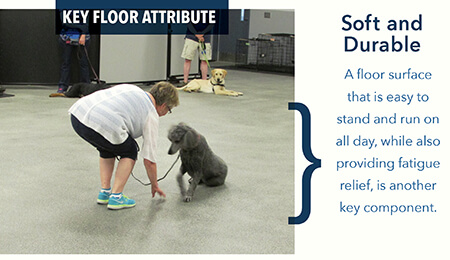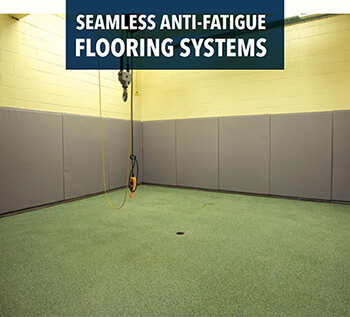
Flooring for Dog Daycare Rooms - Pawsibly the Most Difficult Decision
By Jeff Adney
Whether building new, renovating an existing facility, or remodeling your current building, choosing the right flooring for your indoor areas can be an overwhelming task. With so many products available, how do you decide?
Flooring Characteristics
First, consider the key attributes and the important role they play in indoor daycare areas.
Clean-Ability – Flooring that is easy to clean, coupled with slip resistance is one of the most requested attributes. Because daycare rooms are rapidly becoming the busiest and most used rooms, providing a safe area for both staff and canines is top priority. Most standard floors overcompensate for slipping by creating a textured surface. This, however, can create issues because the more textured floor, the more difficult they are to clean and maintain.

Soft and Durable – A floor surface that is easy to stand and run on all day, while also providing fatigue relief, is another key component. A more pliable floor also gives the dogs traction and provides added safety as the floor gives a bit as weight is put on it. Unfortunately, the trade-off with most (but not all) floor options is that soft does not necessarily translate into long-term durability.
Seamless – Having a seamless option is always important to animal care facilities and especially for dog daycare rooms. Because these rooms are greatly utilized, the opportunity for “accidents” increases exponentially. Any floor surface that has “open” seams is never a good idea. Welded seams are an option but the seam integrity can be compromised if not properly installed and is affected by the stability of the surface below. Seams are also areas that allow for the growth of mold, mildew, and bacteria. And when fluids penetrate, the seams can be a home to smells that never seem to go away.
Aesthetics – An aesthetically pleasing floor improves employee morale and communicates to your customers that their dogs are enjoying a facility whose owners and employees are proud of where they work. Additionally, the nicer the floor, the more motivated employees are to maintain a clean and professional look.
Noise – Dog daycare rooms can be loud. Hard floor surfaces allow the sound waves to continue to bounce around the room and do nothing to help lower the decibels. Most soft floors will allow the noise to be absorbed, thereby lowering the amount of decibels. A quieter room benefits employees and clients and will help dogs stay calm and therefore become less aggravated.
Flooring Choices
Once you have considered the main attributes, the next step is to match them to the various flooring options to determine the option that best meets your needs.
Rubber Matting
Rubber matting is a non-slip surface that when first installed, is very comfortable and does appear easy to clean and maintain. It also minimizes noise with sound deadening properties. Mats generally come in rolls 4’ wide and 25-50’ long, or in individual tile form. The material is either permanently glued to the floor using a polyurethane-based industrial adhesive, double-sided tape, or a bonding compound. A topical sealant can be used and installed on top of the mat to help create a water resistant surface, which then aids in helping keep floors clean and free from bacteria build up. The downside is that all sealants are not created equal and most will degrade and need to be reapplied. If you do not stay on top of sealing the mat, it will eventually wear and need to be replaced.
Common complaints in regards to the rubber matting include dogs can dig into it and create divots, as well as the dogs’ pads get black from the matting. Seams usually are the weak link and once the seams separate, the quicker the floor deteriorates. Continual sealant build up can create a slicker surface on top and begin to make the rubber floor hard. Additionally, dogs’ nails can scratch the sealant.
Please check with your local Department of Agriculture or other regulating authority. Certain states are now regulating the types of floors that can be used in dog daycare areas. If already installed, they may request that you remove rubber matting and replace with a non-porous surface. Although rubber matting is a high traction floor, the flooring can still result in injuries as the dogs can stop too quickly and tear ligaments and joints. Other common complaints include odor absorption and fading, both of which are accelerated by exposure to ultraviolet light.
Artificial Grass
Although artificial grass typically is installed outdoors, it can also be a great option for interior use. Following the manufacturer recommendations is absolutely critical to providing an effective long-term solution. All too often, when the artificial turf is installed inside, it gets an unjustified bad rap due to odor issues, cleaning, and other house-keeping and installation related issues. These complaints are not necessarily the cause of the grass, but more often due to an improper installation or the wrong “type” of artificial grass being used. When installed properly, not only does it look great and provide safe traction for the dogs, but it also can become a hygienic floor solution due to a built in anti-microbial agent provided by some manufacturers. When considering artificial grass for interior uses, it is critical to have a flushing system underneath and the grass elevated on a platform.
Ken Karmie (K9Grass Product and Brand Manager) outlines the following consideration for success with artificial grass in animal care facilities:
- Start with the right product
- Have it installed properly
- Understand maintenance protocol and follow it
- Have an effective HVAC system that will facilitate adequate drying
- Have at least one trench drain with floor sloped properly and an appropriate drain cover to receive the liquid waste
- Have a completely sealed, non-porous floor surface underneath the turf, such as a 100% solids epoxy to seal
- The floor must have the appropriate pitch to the kennel drains, which is a minimal 2% - 3% slope or ¼” drop per foot.
- Seal the edge, curb, or adjoining walls where the grass abuts up to a minimal height of 36”
- Fasten down the edges of the grass properly
There are also additional steps that must be followed for proper results with an elevated floor with a flushing system.
It is also important to budget for the additional cost of sloping the floor when it comes to renovation of an existing building or remodeling, and budget for the proper HVAC. Seek out an animal care HVAC specialist to help you plan accordingly.

Seamless Anti-Fatigue Flooring Systems
Completely seamless anti-fatigue flooring systems are now available and are rapidly becoming the new trend in dog daycare flooring. Available in varying thicknesses, these floors are a combination of either epoxy, rubber matting, rubber pellets or vinyl flake, and flexible seamless topcoats. Benefits include stress reduction for the dog’s joints, legs, back, and muscles as well as those of their human caretakers. They also help to reduce sound decibels, and are decorative, functional, and cost-effective. Another bonus is that texture can be adjusted on demand. The textured floor system provides a mild anti-skid element that won’t hurt pads or paws while still allowing for easy clean-ability. It is completely non-porous with little maintenance upkeep, and no waxing or continual sealing is required. As an added advantage, complete seamless floor to wall junctions can be achieved.
Like all flooring options, a good installation to applicable area is critical. HVAC still plays a critical role in pulling moisture and humidity out of the area. Because the floors are completely non-porous, the moisture does not soak or penetrate into the floor. When humidity gets too high, the condensation can then sit on the surface making for a wet, sweaty feel. Proper preparation is critical in that these surfaces bond directly to the substrate below. Testing and measuring moisture content and vapor transmission in concrete prior to installation is a must. This is not a do-it-yourself application; working with the various products require a person trained with the proper skills.
Chris O’Brien, CEO of Prime Coat Coating Systems™, explains how their “Soft Paw” anti-fatigue system offers potential endless uses. “It not only solves the issues of having a floor surface that is easier and safer for the dogs to run on all day, but is also hygienic, seamless, and durable while providing the added bonus of sound reduction. This engineered floor is not only suitable for dog daycare areas, training rooms, and rehabilitation rooms, but also tough enough to be installed in large animal holding and treatment areas. Because the key components require intimate knowledge of set times, spread, and coverage rates, they limit the installation to only trained licensed installers. With almost all floor products, application is key.”
Seamless anti-fatigue floor options can be installed in virtually all building options; new build, renovation, and remodel. Due to the seamless nature, they do not require the added expense of floor drains to be installed. However, drains can be incorporated easily if desired.
The flooring solution you ultimately choose will be decided by your use, ease of cleaning, aesthetics desired, and budget. There are many options available and deciding what type works best for you is not only a budget driven decision, but also a decision based on your wants, needs, and desires. A good installation is a constant for all types of floors. When it comes to flooring, there are no short cuts, unfortunately. Seek out industry experts to understand how the area is truly to be used, how it is to be cleaned, and invest in the proper HVAC.
Jeff Adney is Sales and General Manager for PermaTek Coatings – “Animal Care Flooring by the Animal Care Experts.” PermaTek Coatings is a national company that specializes in installing floor and wall coating solutions specifically for the animal care industry. PermaTek offers decorative and durable solutions that apply to virtually all areas of the facility, promoting a professional, attractive, and hygienic work space. Jeff has been involved in the Animal Care Industry for more than 16 years and continually works to develop new systems to meet market demands. Contact Jeff at [email protected] or 937-780-1075. www.permatekcoatings.com


